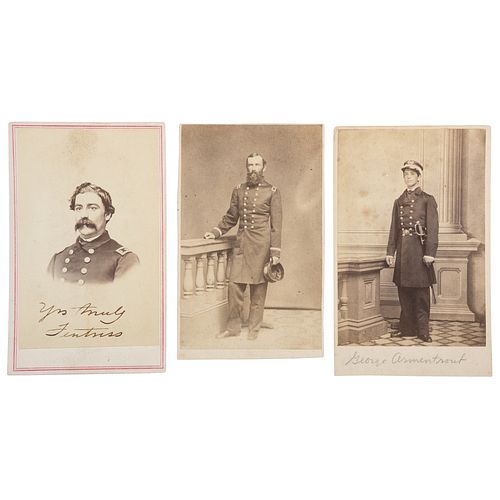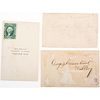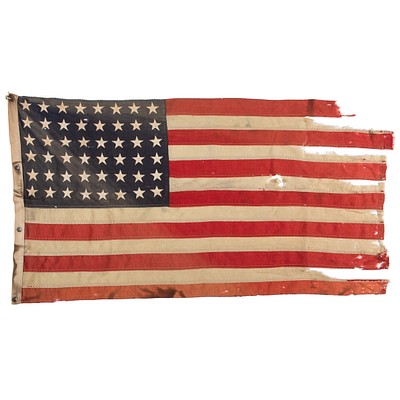Three CDVs of Identified Brown Water Navy Officers, Incl. Moses Kirkpatrick, USS St. Clair Pilot, and Walter Fentress, POW Libby Prison
About Seller
6270 Este Ave.
Cincinnati , OH 45232
United States
With offices in Cincinnati, Cleveland and Denver, Cowan’s holds over 40 auctions each year, with annual sales exceeding $16M. We reach buyers around the globe, and take pride in our reputation for integrity, customer service and great results. A full-service house, Cowan’s Auctions specializes in Am...Read more
Two ways to bid:
- Leave a max absentee bid and the platform will bid on your behalf up to your maximum bid during the live auction.
- Bid live during the auction and your bids will be submitted real-time to the auctioneer.
Bid Increments
| Price | Bid Increment |
|---|---|
| $0 | $25 |
| $500 | $50 |
| $1,000 | $100 |
| $2,000 | $250 |
| $5,000 | $500 |
| $10,000 | $1,000 |
| $20,000 | $2,500 |
| $50,000 | $5,000 |
| $100,000 | $10,000 |
About Auction
Jun 26, 2020
Cowan's Auctions is delighted to present the June 26 American Historical Ephemera and Photography Auction, including 55 lots devoted to the African American experience, over 175 lots dating from the Civil War Era, and more than 60 lots documenting life in the American West. Cowan's Auctions dawnie@cowans.com
- Lot Description
Three CDVs of Identified Brown Water Navy Officers, Incl. Moses Kirkpatrick, USS St. Clair Pilot, and Walter Fentress, POW Libby Prison
Lot of 3 CDVs of naval officers.
CDV pencil identified on verso as, "Moses Kirkpatrick/Pilot US Gun Boat/St. Clair." Uncredited: n.d. Pilot is not a commissioned rank so Kirkpatrick is not found in the Navy List. USS St. Clair was a stern-wheel streamer taken up from the civilian trade and commissioned at St. Louis on September 24, 1862. The vessel first undertook obscure waterborne "reprisal and indemnity duties" on the Cumberland and Tennessee Rivers followed by convey duty on the Cumberland River in support of operations against Nashville. On February 3, 1862, St. Clair engaged in a three hour bombardment of Confederate infantry near Dover, Tennessee. She continued convey duty through the spring and while passing near Palmyra, Tennessee on April 3 was hit by Rebel shore based artillery crippling her machinery and necessitating towing. Next day the town of Palmyra was burned by the Navy in retaliation. St. Clair underwent repairs at Cairo and rejoined the Mississippi Squadron in June as Gunboat No. 19 for Vicksburg operations. Later in the summer she patrolled the lower Mississippi in support of the Army and was involved in a freak collision with the gunboat USS Hope that consequently sank. During Red River operations St. Clair was ordered to Baton Rouge and engaged Confederate shore batteries below Alexandria "while silencing gun positions at Dunn's Bayou and Wilson's Bend." During Banks' withdrawal she safely transported Union troops back to the Mississippi and "engaged Rebel troops at Eunice's Bluff" on May 15th. Patrolling on the lower Mississippi consumed the rest of the summer until August when St. Clair put into Mound City, Illinois for repairs. From the New Year St. Clair once more escorted troop convoys on the Tennessee River ending the war at New Orleans with the Mississippi Squadron. St. Clair was decommissioned on July 12, 1865 and sold at auction in August.
CDV of a sanguine looking young officer standing proudly with his sword, double signed in pencil beneath portrait as, "George Armentrout" and again in ink on verso, "George Armentrout/US Navy." Uncredited: n.d. George Armentrout spent most of the war at the Naval Academy as acting midshipmen from 11/21/61, graduated 11/22/64, ensign 11/1/66, master 12/1/66, lieutenant 3/12/68, lieutenant commander 3/26/69, died in service 8/13/75.
CDV signed in ink beneath portrait, "Yrs truly/Fentress." J.W. Taft: Memphis, TN, n.d. Green three-cent revenue stamp on verso. This officer is wartime commission Walter E.H. Fentress: mate 12/11/61, acting ensign 8/27/62, acting master, discharged 9/13/67. Fentress was probably a rating and then petty officer with over a decade of service before the war. Although it is suggested in one source that Fentress accompanied Commodore Perry on the expedition to Japan in July 1853, this cannot be otherwise confirmed. During the war Acting Master Fentress was captured on September 13, 1863 by marauding Southern cavalry at Rodney, Mississippi while attending church with "twenty crewmen of the USS Rattler." Fentress was held at the infamous Libby Prison in Richmond until exchanged in October 1864. Fentress later took command of the stern-wheel gunboat USS Mist in March 1865 until she was decommissioned in August. Post-war, Fentress served aboard the USS Canandaigua on the Far East Station before leaving the Navy and returning to Michigan where he lived until 1892. The Fentress Papers, 1858-1892, are in the Collection of Rutgers University Library.
Provenance: The Richard B. Cohen Civil War CollectionKirkpatrick carte trimmed back to albumen with moderate wear, G. Armantrout CDV with average clarity having once been affixed to a mount now pulled away. Ink signature not affected. Soft top corners, else about VG. Fentress CDV with strong clarity showing a small area of brown toning above the head. Left corners sharp, right corners dented. Overall VG. Fentress imageCondition
- Shipping Info
-
Buyers are required to pay for all packing, shipping and insurance charges. Overseas duty charges are the responsibility of the successful Bidder. Be aware that for larger and/or valuable items, shipping charges can be substantial. - If there is no shipping amount on listed your invoice, you will need to make arrangements to pick up or ship your purchase through an alternative shipping company. Our shipping department can be contacted at 513.871.1670 (ext. 219) or email shipping@cowans.com. - Shipping charges include insurance for your order while in transit. If you have private insurance we will adjust your charge to include only packing and shipping. - Please allow 14 – 21 days after payment to package and ship your purchase as carefully as possible.
-
- Buyer's Premium



 EUR
EUR CAD
CAD AUD
AUD GBP
GBP MXN
MXN HKD
HKD CNY
CNY MYR
MYR SEK
SEK SGD
SGD CHF
CHF THB
THB












